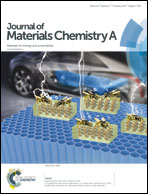Reduction of charge recombination in PbS colloidal quantum dot solar cells at the quantum dot/ZnO interface by inserting a MgZnO buffer layer†
Abstract
Interfacial charge recombination occurring at the interface between a colloidal quantum dot (CQD) solid and the electron collecting layer (ECL) in CQD solar cells significantly affects the charge carrier collection, therefore limiting the device photovoltaic performance. In this work CQD solar cells with an improved performance are reported by employing MgZnO as a buffer layer (BL) with tunable electronic energy levels in the solar cells to reduce interfacial charge recombination and hence improve the solar cell photovoltaic performance. The effect of the BL on the solar cell performance is experimentally investigated and compared to theoretical calculations. Incorporation of a BL with favorable electronic energy levels forming a suitable band alignment with the CQD layer in solar cells diminishes the interfacial charge recombination and an increased photovoltage can be obtained. A CQD solar cell with a BL shows a power conversion efficiency of up to 9.3%, compared to that of 8.2% for a solar cell without any BLs. The unsealed solar cells are also rather stable under ambient conditions both in the dark and under continuous illumination. This work suggests that a MgZnO BL with energy level tunability provides a potential strategy to improve the interfacial properties of CQD photovoltaic devices.


 Please wait while we load your content...
Please wait while we load your content...